Uncategorized
„Open, to love“ (in Erinnerung an Gudrun H.S.)
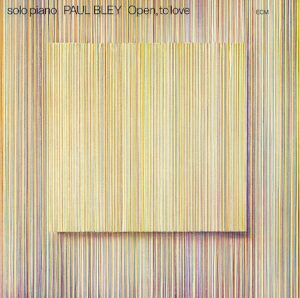
Zuweilen kommt zu einem unvergesslichen und unerschöpflichen Album auch noch ebensolches Cover!Ich werde, wenn dieses Album, das 1973 veröffentlicht wurde, am 7. März innerhalb der „Luminessence“-Vinylserie von ECM neu aufgelegt wird, dazu etwas schreiben. Es wird auch in der Kolumne „Archive“ vom März seinen Platz finden.
Mich erreichte heute schon ein Exemplar, und es ist nicht billig, wenn man es, als Gatefold, und mit einem neuen (und hervorragenden) Begleittext versehen, kauft, für knapp unter vierzig Euro. Aber ich denke, es lohnt sich, lapidar gesagt.
Nicht, weil es ohne Zweifel zu den grössten Solopianoalben aller Zeiten zählt, sondern, weil, ich gerate etwas ins Stocken, ähem, nun, weil es ein Album ist, zu dem der, der sich einmal in dieses Album hat fallen lassen, wohl immer wieder hingezogen fühlen wird. Lebensbegleitend. Wie das Cover.
Manfred Eicher sprach von „Songs“. „Open To Love“ hat etwas dermassen Verlockendes, Entrücktes, In-Aller-Ruhe-Berauschendes! Was er da anstellt mit seinen eigenen Kompositionen, mit denen von Carla Bley und Annette Peacock, ist einzigartig und atemberaubend. Seite 2 endet mit einem Stück vom Annette, das mich mehr als einmal zu Tränen gerührt hat, und einen Titel hat, der auch nachhallt: „Nothing Ever Was, Anyway“. Vom Nachhall könnte man hier noch viel erzählen.
Die Musik von „Open, To Love“ hat mich begleitet von Dortmund nach Münster, nach Würzburg, nach Furth i. Wald und zurück nach Würzburg, zurück nach Dortmund, und Ewigkeiten später von dort nach Aachen. Diese Musik wird nie aufhören, mich gefangen zu nehmen, mich zu fesseln, mich aus Begrenzungen hinaus zu begleiten, offen dafür, zu lieben! Mit dem Album verbinde ich auch das gute alte Wort „surrender“.
Ich frage mich, ob es Leser gibt, die das hier lesen, und das Album nicht kennen.
Ich traf Paul Bley in den noch recht jungen Neunziger Jahren in Bremen, natürlich sprachen wir auch über dieses Werk, und ich werde mal gucken, ob mein Porträt, eine alte Ausgabe der „Studiozeit“, noch irgendwo im Archiv des Deutschlandfunks abgelegt ist. Kleine Anekdote: an dem Tag meines Interviews verkaufte ich ihm mein allerfeinstes Sennheiser Stereo Mikrofon, fair enough, zum Einkaufspreis – es wurde bald ein Sammlerstück.
(m.e.)
Song des Tages
Nächste Woche habe ich frei – na ja, bis auf Montag, da ist eine fünfstündige Dienstbesprechung und bis auf den Berg auf meinem Schreibtisch. Aber immerhin. Bis dahin höre ich noch ein paar Mal den neuen Song von Lucrecia Dalt, bei dem David Sylvian mitmischt (production, mixing) und am Ende auch noch ein paar Zeilen raunt. Deep, hypnotic stuff.Eno on Ibiza, 1977
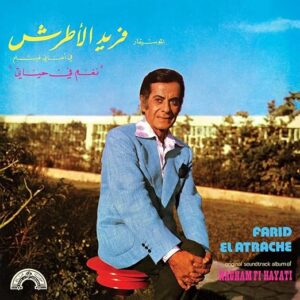
The day before yesterday Brian gave his last lecture on school of songs. Here is one story he told, and I‘ve never heard it before. And after that, listen to the song he has been hunting down fourteen years. Not long ago, WeWantSounds reissued the album containing that track. By the way, it was 1977 when he heard the song for the first time, a time where „global music“ was not yet somthing for everyday. The records that were mirroring music from far away places were not so many … after Tom Scott’s Music For Zen Meditation, after Don Cherry’s Brown Rice, after Yusef Lateef‘s Eastern Sounds, all reflecting north african, arabic style musics or sounds from the far east, it took a time til, at the end of the 70‘s, at the begnning of the 80‘s that thing called „world music“ entered Western cinsciousness, and the market became, after quite some time, a big one: from originals to creative fusion, and pure mainstream on the other end of the spectrum.looking back on eno‘s seminar on songwriting
I even wrote one song in these weeks, a spoken-word piece with a bit of singing – 😉 – called „Ein kleiner Strand“. I like it enough to post it here one day… in case, Tommy Perman and Jan Bang add their magic! It was a great experience to come together with people from all over the world. Hello, Tom Boon! But, I am so familiar with Brian‘s thoughts, and not really planning to write songs in the future, that it had a kind of nostalgic vibe. Brian is in the years now, as we all are who grew up with his music from the 70‘s onwards. And, apart from his clear and humourous ways of lecturing, the Brian who keeps surprising me most, is the Brian putting out new albums. Secretly, I am hoping fo another song album. What he did on „Foreverandevernomore“ was definitely a fantastic late work, opening new gates of perception with a voice and vocals that have aged well. The song he created for Eno, the documentary, „All I Remember“ showed clearly that he can still write songs that are more connected with a sensual and visceral memory, instead of the dark time travel songs of a distant future (the near future yesterday threw some dark shadows on politics in Germany with fucking right wing fascists and a future Kanzler counting on their voices). And it was a very personal song. Why not do a whole work of such sophisticated, sentimental torch songs!? An artist who regularly refuses to write confessional songs would surprise us one more time. By the way, my song „Ein kleiner Strand“ has a distant echo of Seven Regener‘s songs, but it is not a love song, and will have, in its final version (that probably never sees the light of day) more electronics inside.
Rich und seine Songwerkstatt (3/3)
Heute nun der letzte Teil meiner kleinen „Nacherzählung“ von Toms Begegnung mit Rich anlässlich seines Album „End Of The Middle“. Das ist mal ein Beispiel für einen Songzyklus, bei dem es fast unerlässlich ist, die lyrics zu verstehen. Drum liegen sie dem Album bei, und den Schlusssong „More Than Real“ kann man bei „comment 1“ lesen. Verglichen mit der überbordenen Klangfantasie seiner letzten Alben ist dieses Werk viel mehr Schwarzweiss und Neorealismus als Cinemascope und History Fiction. Dennoch schleicht sich das Element des Fantastischen bei Richard Dawson weiterhin ein, in unerwareteten Sprüngen zwischen Traum und Wirklichkeit in den lyrics, in seinem Gitarrenspiel, den ungewöhnlichen Phrasierungen seiner Stimme, in den amarchischen Beimengungen einer Soloklarinette (ich habe es immer schon geliebt, wenn ein Blasinstrument in einem Lied nicht die gepflegte Melodielinie spielt, sondern Unruhestifter ist statt schmückendes Ornament). Der Wire schreibt, in seiner Märzausgabe zu dem Album folgendes:
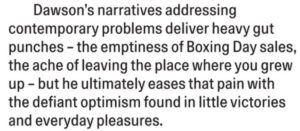
Nach ein, zwei Tagen wandert dieser Text im Blog Diary soweit in die Vergangenheit, dass man den Gesamttext in aller Ruhe und Chronologie „von oben nach unten“ lesen kann. Er wird dann im März zu unswrer TALK-Kolumne bei den MONTHLY REVELATIONS stossen. Nichts geht natürlich darüber, sich die UNCUT vom März zu kaufen. Darin, unter anderem, eine „in depth“-Story, über das Album von Wilco, das immer meine Number One war: „A GHOST IS BORN“ – ein Titel, der auch gut zu einem Album von Rich passen würde. (m.e.)
MORE THAN REAL
„More Than Real“ ein überraschend farbenfroher Abschluss des Albums. Es ist ein Duett mit Sally Pilkington, der die ersten Akkorde und die Melodie geschrieben hat. Es ist ein zutiefst emotionaler Blick auf die Entschlossenheit und das Scheitern eines frischgebackenen Vaters, und dann – vielleicht – eine Momentaufnahme der Zukunft, wenn seine Tochter einen Anruf erhält und zu seinem Krankenhausbett eilt, um sich zu verabschieden.
„Sally und ich sprachen, was dieses Finale angeht, über Angelo Badalamenti und die Dokumentarfilme, die man auf BBC sieht, wo die Hintergrundmusik anschwillt, wenn es einen emotionalen Moment gibt,“ erklärt Dawson. „Aber der Song sollte eine seltsame Version davon sein. Ich dachte auch an Tarkovskys Andrei Rublev – der Film ist in Schwarz-Weiß, und am Ende, nachdem ein Junge 25 Minuten lang eine Glocke gemacht hat, wird er plötzlich in Farbe gezeigt. Ich wollte, dass dies der farbige Moment nach einer ziemlich entsättigten Erfahrung ist. Ich habe auch an Neil Youngs ‚Philadelphia‘ gedacht – es ist sirupartig, irgendwie kitschig, aber es hat eine schöne Stimmung.“
„Es war ein Song, den ich schon eine Weile auf der Orgel gespielt hatte und der mir schwer fiel, ihn zu beenden“, fügt Pilkington hinzu. „Richard hatte es im Visier und bat mich schon seit einer Weile darum. Ich habe gezögert, aber ich habe mit ihm verhandelt – er konnte es haben, wenn ich Teil des Tracks sein konnte“. (So verhandelt ein Paar über einen Song – ich musste bei den Schilferungen ihres Alltags manchmal an Robert Wyatt und Alfie denken.)
ALLEINE IM DUNKELN
Rich Dawson hat mehr Grund als die meisten anderen, das Leben auf dem Lande als schwierig zu empfinden: Er ist sehbehindert, und seine Sehkraft wird langsam schlechter. In den letzten Jahren ist es für ihn schwierig geworden, damit umzugehen.
„Ich bin ziemlich auf Sally angewiesen, sie hat mich schon oft mitgenommen“, sagt er, während er ein frisches Pint Village Green (sein Lieblingsbier!) auf dem Tisch stehen hat. „Es ist haarig, von der Bushaltestelle nach Hause zu laufen – der schnellste Weg führt über die Felder, ein kiesiger Weg in der Dunkelheit, schnüffelnde Tiere, und ich kann nichts sehen, verdammt. Ich denke: ‚Ich habe Angst, und ich werde die nächsten 25 Minuten Angst haben. Aber die positiven Seiten des Lebens hier draußen sind so groß.“
Im März 2023 spielte er seine erste amerikanische Headline-Show in New York und reiste dann quer durch die Staaten, um seine Freunde Pigs Pigs Pigs Pigs Pigs Pigs Pigs zu unterstützen. Natürlich ist Amerika kein Ort für öffentliche Verkehrsmittel, und selbst in den Großstädten kann schlechtes Sehvermögen zu einigen Schrammen führen.
„Es war ein bisschen viel für mich, um ehrlich zu sein, da draußen allein zu sein“, seufzt er. „Ich fühlte mich ziemlich gestresst. Die Shows waren alle großartig, aber man muss sich bewusst sein, wer um einen herum ist, und ich konnte nicht genug Informationen [visuell] über die Leute bekommen, so dass ich in ein paar Begegnungen geriet. Einmal war ich in der New Yorker U-Bahn und diese furchterregenden Typen stiegen in Kampfhosen und Stiefeln ein – sie stiegen an jeder Tür ein und fingen an, auf mich loszugehen, es waren Gang-Typen. Es fühlte sich auf jeden Fall gefährlich an. In L.A. habe ich mich dann einfach verlaufen und ein Vermögen ausgegeben, um irgendwo hinzukommen. Ich habe es also nicht geschafft, sagen wir es mal so.“
ENERGY FOOLS THE MAGICIAN
Dawsons jugendliche UFO-Sichtung wird in der ersten Hälfte von „Black Triangle“ aus dem Jahr 2020 erzählt, ein seltenes Stück Autobiografie in einem Lied. „Es war wirklich sonnenklar. Mein Freund und ich sahen beide dieses massive schwarze Dreieck über uns hinweggleiten. Mir ist jetzt klar, was für ein großer Moment das war. Es gibt die Vorstellung, dass ein Song irgendwie autobiografisch sein muss – und das ist er natürlich immer, in gewisser Weise. Aber es war sehr überraschend für mich, dass die Leute nach ‚Jogging‘ dachten, ich würde gerne joggen gehen.
„Wir haben diese enge Vorstellung davon, was ein Song sein sollte, und die haben wir bei anderen Kunstformen nicht. Er muss radiotauglich sein, er muss vier Minuten lang sein, er muss fröhlich sein, er muss uns helfen, zur Arbeit zu fahren, er muss in unseren Tag passen. Und ich glaube nicht, dass das der Ursprung ist. Bevor jeder Zugang zum geschriebenen Wort hatte, war ein Lied für die Menschen eine Möglichkeit, Nachrichten zu teilen und zu verbreiten. Es ist eine Form von Magie.“
Nachspiel: The bizarre history of Dawson’s favourite guitar
“In my early twenties I had to get a loan to pay for backdated council tax, and I had a few hundred left over so I bought this Baby Taylor. Lovely guitar. Then it had a series of mishaps. There was a minor earthquake in the UK and I’d forgotten I’d put it on the floor, and I stood on it, but it was still playable. The second time, I was drunk and I totally caved it in, but it still made a sound of sorts. I thought, ‘Well, I’ll just play the songs the same, the spirit will still be there even if it sounds terrible.’ Then [singersongwriter] Nev Clay stood on it and totally broke it – it was my fault. A luthier, Nigel Forster, put a beautiful curved top on it, and it was vastly improved. Then the neck snapped on the first day of the Peasant tour. I don’t gig with it now, but every song I’ve written since my twenties has been written on that.“
Die neuen Rechten in deiner Strasse

Es ist nicht nur so, dass die politische Sozialisation allein auf Plattformen stattfindet, die politische Wahrheiten Lügen strafen und so eine junge Generation Halbgebildeter der AfD zutreiben.
Es ist auch so, dass man einer, zugegeben sehr kleinen Gruppe von sog. Intellektuellen, die man eher beim linken Flügel der SPD (gibt es den noch?) oder bei den Grünen vermutet, neuerdings Sympathien für die Rechtspopulisten der AfD feststellt. Manche sagen dies offen, manche zögerlich. Manche schwafeln dumm herum. Manche halten die Partei tatsächlich für eine wählbare Alternative, etwa, wenn sie sich von ihrer rechtsradikalen Jugendorganisation trennen. Nun, das ist jetzt geschehen. Oder, wenn Höcke nicht ihr Kanzlerkandidat ist. Nun: so sieht es aus.
Mit solchen verkappten Sympathiebekundungen konfrontiert, rudern sie nur halbherzig zurück. In zwei Fällen, bei mir in der der Nähe, besuchen solche „neuen Sympathisanten“ öffentlich Kundgebungen der Partei von Weidel, Höcke und Co., und sie sparen nicht mit Beifall, wenn sie sich unter ihresgleichen bewegen. Herr Wallraff, wäre er noch im Einsatz, hätte eine Menge zu berichten, undercover. Ich stellte einen zur Rede, freundlich, aber deutlich, und seine sonst immer nette Fassade wechselte in den Hassjargon: „Kümmer dich um deinen eigenen Dreck.“ „Das ist erbärmlich“, entgegenete ich, „zuletzt sprachen wir noch über unseren Sommerurlaub“, aber da hatte er schon abgedreht.
Die 21 Millionen plus/minus kommen aus allen Ecken der Gesellschaft. Wir können es in diesem Winter in Deutschland, vor der Bundestagswahl, es nicht bei moralischer Entrüstung oder Resignation belassen. Wer die AfD verhindern will, tut gut daran, im kleinen Kreis die Empörten, Gefrusteten anzusprechen, die leichtfertig ihre Stimme der AfD geben wollen. Die meisten von uns kennen solche „Kandidaten“. Ich bin kein Freund der Israelpolitik der Grünen, und ihrer bloss mahnenden Worten an offiziell anerkannte Kriegsverbrecher, aber ich sehe keine Alternative. Simpel, aber wahr: jede Stimme zählt! In der Auseinandersetzung mit der AfD darf es keine Restsympathien geben, kein „vielleicht“, nur klare Kante!

Wer etwas Geld hat, könnte zum Beispiel Campact unterstützen, die demokratischen Widerstand gegen die Neue Rechte leisten. Die Unterstützung klug organisierter Aktionen gegen die AfD ist bedeutsam in diesen Wochen vor der Bundestagswahl, in denen der designierte Kanzlerkandidat Merz gerade den Trump gibt, und die Brandmauer gegen die AfD zu bröckeln droht. Eine ganz gefährliche Entwicklung.“Sei erschütterbar und widersteh“, so textete einst Peter Rühmkorf, und als ich jüngst sein ECM-Album „Kein Apolloprogramm für Lyrik“ wieder mal hörte, konnte ich es leicht als Resonanz auf unsere Jetztzeit in deutschen Landen erleben. „Haltbar bis Ende 1999“ lautete der Titel meines Lieblingsbandes von ihm, den ich damals, in der alten BRD, auf Langeoog in einer Buchhandlung nah am Strand erwarb. Auf dem Cover ein überquellender Aschenbecher.
Einmal, im April des letzten Jahres, brachte ich ein, zwei Strophen aus einem Rühmkorf-Gedicht zu Gehör, in den letzten sieben Minuten der damaligen Ausgabe der JazzFacts: HIER nachzuhören!
Antifaschistische Grüsse!
Rich und seine Songwerkstatt (2/3)
Nach Enos „Songwebinar“ stiess ich auf einen sehr, sehr langen Artikel von Tom Pinnock in der Märzausgabe von Uncut über Richard Dawson. Und dieser Artikel ist preisverdächtig. Rich ist ein dankbarer Gesprächspartner, ein Füllhorn des Exzentrischen, privat, und in seiner Musik, aber diesen Mix aus Biographie, Songanalyse, Erfahrungsbericht, Storytelling und Interview muss man erst mal so hinkriegen. Nicht jeder wird sich mit Dawsons neuem Album „End Of Middle“ auf Anhieb anfreunden, dessen Kernthemen das Ungewöhnliche am sog. „gewöhnlichen Leben“ sowie die Weitergabe von Traumata von einer Generation zur nächsten sind. Sehr, sehr selten wurde da bis heute in einem Songalbum abgehandelt.
Und gerne verdichte ich das alles ein wenig in meiner kommentierten Nacherzählung. Er wollte sich in diesem Werk gar nicht so weit wie sonst in kühne Soundwelten begeben, sondern möglichst normale Songs schaffen, mit Melodie, Text, den basics, und „ohne die zusätzlichen Kameraschwenks“. Und das er bei den fernen Echoräumen dieses Konzeptalbums auch bei Neil Youngs Album „Zuma“ landet, ist eine Pointe des zweiten Akts dieses Dreiteilers. Und dass der Schuppen, in dem er all die Songs dieses neuen Werks geschrieben hatte, von einem Sturm zerstört wurde, kurze Zeit nach der Fertigstellung des letzten Stückes, gehört zu den surrealen Bestandteilen dieses Porträts.
Noch ist es mir nicht gelungen, einen Song des Albums an einer perfekten Stelle meiner März-Klanghorizonte unterzubringen (siehe „monthly revelations“ – RADIO), aber ist ja noch viel Zeit bis dahin.
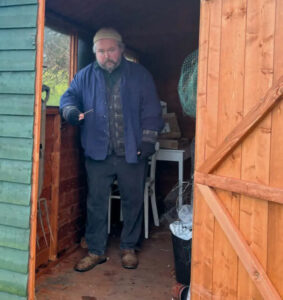
Wir stapfen durch vereiste Gassen zurück zu Richs Haus, einem Reihenhaus aus dem 19. Jahrhundert, in das er und Sally im Jahr 2020 eingezogen sind. Bis dahin hatte er sein ganzes Leben in Newcastle verbracht, ihr Auto, das auf den Namen Naomi getauft wurde, steht auf der Rückseite des Hauses, während der Garten einen Apfelbaum, eine kompakte Sauna und eine Schar von Gnomen beherbergt. Während sich die beiden drinnen Tee und selbstgebackenen Apfelkuchen holen, ruht ihre schwarze Katze Trouble auf gemusterten Decken auf dem Sofa. An der Wand hängt Dawsons Lieblingsgitarre, eine modifizierte Baby Taylor. „Ich spiele sie jeden Tag“, erklärt er. „Von ihr kommen alle Songs. Sie ist eine Tür, eine Rettungsinsel, ein Spiegel. Es ist ein Zauberstab.“
Eine Reihe von Schallplatten repräsentiert Dawsons vielfältigen Geschmack: Es gibt große Abteilungen für The Fall, Sun Ra, Rajasthani Straßenmusik, Laurie Spiegel, Eliane Radigue, Guy Klucevsek Gas, Sonny Sharrock und John Coltrane, unter anderem. „60 Horses In My Herd“ von Huun-Huur-Tu, das ist eine Schlüsselplatte für mich“, schwärmt er. „Ich habe so viel darüber gelernt, wie ich singen will, vor allem bei diesem einen Stück. Es wird nie alt.“ Diese Einflüsse ermöglichten es ihm, einen kaleidoskopischen Stil zu entwickeln, der an die Avantgarde und unzählige globale Musiken ebenso anknüpft wie an seine „Open-Tuned“-Gitarre, britischen Folk oder transatlantischen Rock. Sein Produzent Sam Grant sah ihn zum ersten Mal ein oder zwei Jahre vor dem 2011 in einem italienischen Restaurant in Newcastle, das experimentelle Performances veranstaltete; er war bereits dabei, die Grenzen zu erweitern.
„Wir waren alle beeindruckt“, erinnert sich Grant. „Er hatte die Gabe, einen Raum völlig zum Schweigen zu bringen. Wenn er anfing, gab es ein lautes Gerede im Raum, und dann wurden die Leute nach und nach von der Musik angezogen. Am Ende des Liedes hörte er auf und der Raum war völlig still. Nicht ein Atemzug! Es war immer bemerkenswert.“
Alkohol spielt für die Charaktere auf End Of The Middle eine große Rolle: die Oma, die sich in „Gondola“ durch den Blossom Hill quält; der labile Erzähler von „Knot“, der auf einer Hochzeit einen Geistesblitz hat; der arbeitslose Vater in „Removals Van“, der seine Sorgen in Dosenbier ertränkt. Auf dem Vorgänger The Ruby Cord von 2022 sind die Charaktere schräg, ganz im Sinne des Einflusses von VR-Welten und Pynchon-Romanen. End Of The Middle hingegen präsentiert seine Spieler in grellem Scheinwerferlicht, ihre alltägliche Plackerei beleuchtet komplexe Innenwelten.
„Ich wollte, dass es wie ein Buch von Alain Robbe-Grillet oder Georges Perec ist – ganze Romane, die nur Räume und Zimmer beschreiben. Natürlich wird ein Album anders, als man es sich vorgestellt hat, wenn man anfängt, sich darauf einzulassen. Das Unkraut nimmt überhand. Ich habe dieses Ding hier gepflanzt, aber dann ist es gewachsen und wurde von meinem ganzen Mist erstickt.“
Das Ergebnis lässt tief in die Dynamik und das Trauma von Familien blicken, wobei wiederkehrende Namen eine Kontinuität suggerieren, der Dawson gerne ausweicht. Der Sound des Albums passt zu den alltäglichen Themen: Wo Peasant and The Ruby Cord mit schwingender Geige und manischer Harfe schwirrte und 2020 von E-Gitarren, Drumcomputern und Synthesizern auf einen kantigen Punkt geschliffen wurde, besteht End Of The Middle hauptsächlich aus genau diesem Baby Taylor und Andrew Cheethams zaghaftem Schlagzeug. Dawson erwähnt den frühen Neil Young als Einfluss, ebenso wie Michael Hurley: „Es gibt so viel an Michael Hurleys Platten, das das verkörpert, was ich an der Musik anderer Leute liebe – den Raum zu hören, das Klebeband, wo die Nägel eingeschlagen wurden.“
„Wir wollten, dass es so klingt, als würde Richard in einem Wohnzimmer für alle und niemanden spielen“, sagt Grant. „Es gibt keine Fanfaren, nur eine Bescheidenheit und einen sehr exponierten Sound, der dem Song selbst keinen Raum für Selbstgefälligkeit lässt.“
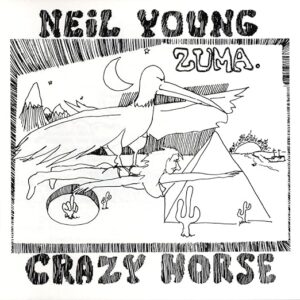
„Richard wollte, dass es wirklich einfach ist“, fügt Schlagzeuger Andrew Cheetham hinzu. „Er bat mich immer wieder, das Schlagzeug ’schwach‘ und ‚zerbrechlich‘ klingen zu lassen, ein bisschen pathetisch. Wir haben es zusammen aufgenommen, den Gesang danach – er wollte dieses Zusammengehörigkeitsgefühl, das man zum Beispiel bei Neil Youngs Zuma hat, dieses entspannte Gefühl.“
Auf dem gesamten Album blitzt immer wieder die Free-Improvisations-Klarinette von Faye MacCalman auf. „Sie spielt eine ähnliche Rolle wie die Geige von Angharad Davies auf Peasant – als eine Schicht aus Frost, gefrierendem Nebel oder Nieselregen“, sinniert Dawson. „Das Album beginnt mit ‚Bolt‘, wo ein Blitz in die Ecken des Hauses leuchtet. Die Klarinette ist wie der Blitz, der in bestimmten Momenten in jedem Song wieder auftaucht, um uns einen Schubs zu geben – ‚Wake up!‘ Als ich ein Kind war, schlug der Blitz tatsächlich in das Haus meiner Familie ein: Mein Vater hatte 10 Sekunden vorher aufgelegt und dann war das Telefon braun und verkohlt. Das war wirklich knapp – etwa 10 Menschen sterben jedes Jahr, weil sie vom Blitz getroffen werden.
Die Düsternis von Dawsons Material wird durch absurden Humor konterkariert, wie in „Bullies“, wo ein Elternteil einen Anruf wegen des Mobbingverhaltens seines Kindes erhält:
“I was in the middle of a Zoom / With one of our most important clients / Majestic Wine…”
„Er hat eine unheimliche Fähigkeit, das Leichte mit dem Schweren zu verbinden“, sagt Grant. „Ich denke, dass die Wachsamkeit oft durch etwas scheinbar Leichtes und Verspieltes gesenkt wird, was es der Musik und den gewichtigen Themen erlaubt, noch ein bisschen härter zuzuschlagen.“
Go down to your radio and trawl the megahertz
Zu den besten Webseiten, das Leben mit Musik, und all die Tangenten ringsum zum Thema haben, zählt neben Richard Williams‘ The Blue Moment, ganz sicher auch eine andere Solo-Seite, Zen Sounds, von Stephan Kunze. Wer genug Geld hat, und Sendungen wie die „Klanghorizonte“ mag, wird dort sehr viel Lesenswertes finden. Heute schreibt er (und wie ich ist er kein Prefab Sprout-Fan), über Paddy McAloons wundersames Soloalbum „I Trawl The Megahertz“, das ich in den Klanghorizonten spielte, rauf und runter, als es erschien, und, bei der Wiederveröffentlichung auch. Sein letzten Absätze lauten (er schreibt in feingearbeiteten kleinen Abschnitten, der Zengartenvergleich ist akkurat):
I Trawl the Megahertz still stands as one of his most personal works. It’s an album with little companions in popular culture, often getting compared to Jon Brion’s soundtrack for Michel Gondry’s film Eternal Sunshine of the Spotless Mind.
McAloon couldn’t have known Brion’s score, as it was written after I Trawl The Megahertz. Instead he mentions Gavin Bryars’ composition “Jesus Blood Never Failed Me Yet” (first released on Brian Eno’s Obscure Records in 1975), which he says he didn’t think of while writing the piece but it might have had a “subconscious influence”.
I Trawl the Megahertz remains totally unique and outstanding. I’ve never even been a huge Prefab Sprout fan, but I return to this brilliant album every so often. Its vague melancholy never fails to move me.

P.S. Mich haben einige Bekannte und Freunde angesprochen, warum ich nicht eine solche Seite eröffne, und damit eine schöne Einnahmequelle öffne. Die Antwort ist einfach: ich möchte über ALLES schreiben können, und da würde ich Abstriche machen müssen: wer will schon dafür bezahlen, dass ich alte Geschichten im Mosaikstil auftische, natürlich auch Fussballgeschichten, Traumdeutungen, monatelang nach meinem Blutsbruder suche, Gedichte, und andere „Abseitigkeiten“. Ausserdem schätze ich, und das zählt noch mehr, Vielstimmigkeit. Solange es sie gibt.
P.P.S. Bald wird Norbert E. eine spannende „Doppelliste“ vorlegen, zu seinen Favoriten der „wilden Siebziger Jahre“. Wieso eine Doppelliste? Ich musste kurz nachfragen, aber, klar, das hätte ich mir auch denken können. Bei mir gäbe es nur eine einfache Liste, ohne Dopplereffekt – das Gavin Bryars‘ „The Sinking of the Titanic“ wäre übrigens dabei, auf dessen Rückseite „Jesus Blood Never Failed Me Yet“ erklingt. (Lieber Norbert, schlage mal ein paar Locations vor für unser Hamburger FlowFlow-Meeting am 1. Mai!)
Rich und seine Songwerkstatt (1/3)
In der Kleingartenanlage, in der Rich Dawson sein neues Album „End Of The Middle“ sorgfältig pflegt, ist etwas in Bewegung geraten. Das jüngste Werk des Singer-Songwriters erforscht die Dynamik und das Trauma von Familien. Beim Blick in den Polytunnel erfahren wir, wie Blitzeinschläge, Gnome, Andrei Tarkovsky und „zerbrechliche“ Trommeln dazu beigetragen haben, Dawsons neueste musikalische Ernte zu einzifahren. „Ein Lied ist eine Form von Magie“, sagt Rich. Aber fangen wir mit dem Anfang an. Dies ist eine stark bearbeitete, aber relativ wortgetreue, zudem teilweise kommentierte, Nacherzählung von Tim Pinnocks Begegnung mit Rich in drei Akten.
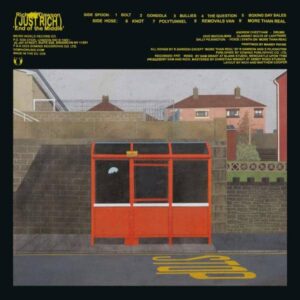
An einem gefrorenen Berghang über dem „Tyne Valley“ zeigt Richard Dawson die Vorzüge einer dezenten Idylle. Grünkohl, Knollensellerie und Knoblauch sind unter einem Netz geschützt, Erdbeeren und Kürbisse im Polytunnel, Kartoffeln sprießen unter durchnässtem Karton und zwei Arten von Artischocken. „Es ist magisch hier oben, nicht wahr?“, sagt er und blickt danei hinaus in die Landschaft. Auf der Hügelkuppe zeichnen sich Pferde ab, und ein dunkelbrauner Vogel kauert auf einem Zaun, während der Tyne unter uns vorbeizieht, ohne dass wir ihn sehen. Doch es ist nicht alles so, wie es scheint.
„Ich hasse den Kleingarten“, sagt er. „Ich habe eine Zeit lang versucht, mir das nicht einzugestehen. Ich hasse alles, was mit Molekülen zu tun hat. Ich hasse es, etwas anzufassen, ich hasse es, einen Körper zu haben, ich hasse es, Kleidung anzuziehen. Das ist alles schrecklich. Ich mag es einfach, mit Worten und Gedanken und Luft zu arbeiten – gasförmiges Zeug, das ist schön, das mag ich.“
Der Kleingarten hat Dawson zumindest die nötige Ruhe verschafft, um seinen gasförmigen Leidenschaften nachzugehen. Dazu gehört auch ein Schuppen, in dem er die Texte für sein neues, achtes Album „End Of The Middle“ geschrieben hat. Darin befinden sich nur ein harter Stuhl, ein winziger Schreibtisch, eine ungeöffnete Flasche Brandy und ein 10er-Pack Boddingtons (acht Dosen unangetastet). Dawson verbrachte dort acht Monate, mit Unterbrechungen, um die Songs zu schreiben. Nicht lange nachdem er fertig war, kippte der Sturm Jocelyn den Schuppen um.
„So zu schreiben ist kein sehr praktischer Prozess“, gibt er zu. „Aber ich weiß nicht, wie ich es sonst machen soll. Pferde kommen und schauen durch das Stallfenster herein, es gibt Raubvögel, herumhuschende Säugetiere und…“ Ein Esel brüllt in der Nähe. „Ein Drache?“
Obwohl Dawson am Tag vor unserem Treffen seinen eigenen Polytunnel reparierte, ist der erste Track von End Of The Middle, „Polytunnel“, nicht autobiografisch. „Das ist die Realität, die die Kunst widerspiegelt“, erklärt er, “nicht umgekehrt.“ Wie viele große Schriftsteller lässt er sich von seinem eigenen Alltag inspirieren, erschafft aber fiktive Charaktere, die sich sehr lebensecht anfühlen. „Alle Figuren sind frisch, sie sind alle sehr präsent“, sagt er.
Einst ein jugendlicher Metalhead, der in ein verlorenes Jahrzehnt abdriftete, hat sich Dawson in den letzten 15 Jahren durch harte Arbeit und Entschlossenheit zu einem Songwriter von außerordentlicher Kraft, einem hervorragenden Gitarristen und einem unglaublichen Sänger entwickelt. Dieser Künstler verbringt fünf lange Wochen damit, einen Song über einen halb verwahrlosten Vater zu schreiben, der seine Tochter vom Fußballtraining abholt, um ihn dann zu verwerfen und einen neuen Text über einen mythischen Oger aus dem sechsten Jahrhundert zu schreiben, der auch eine Parabel auf die heutigen Asylsuchenden sein könnte.
(Fortsetzung folgt)
„in memory of elizabeth reed“
Wie oft habe ich dieses Instrumentalstück gehört. Ich fragte mich immer, wer Elizabeth Reed gewesen war. Die unfassbare Kraft dieses Songs ohne Worte kommt mir in den Sinn, wenn, ich jetzt an G.denke. A celebration of life lived, and yearning.
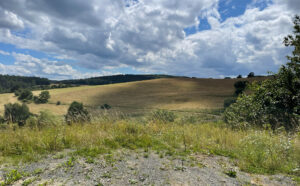
Lieber U!
Das ist so bestürzend. Der Tod von G.
Ich seh uns alle zusammensitzen wie in besten Zeiten,
noch vor so wenigen Wochen.
Wir kommen zur Bestattung und bleiben. Wir übernachten in dem guten Hotel nahbei, Brauers Landart oder so ähnlich, die Beiden kannten die Chefin gut…
Ich hustete wie verrückt, du sagtest, du wärst in 15 Jahren tot, und keiner von uns hat sowas für möglich gehalten… in meiner Fantasie gehörte dieses „Quartett alter Freunde“ einfach zu meinem Bild von der Zeit vor uns dazu, unverrückbar.Und die Zeit hinter uns: einmal, als ich die Unzertrennlichen besuchte, 2023, da holte sie ein altes Foto raus, auf dem ich, im Jahr 1982 zu sehen war, in Arnschwang, mit einer grünen Strähne im Haar, die G. mir gemacht hatte, und die so gut zu meinem knallbunten Käfer passte, der wie eine Hommage an Jackson Pollock aussah, oder wie „Herbie auf LSD“. Ausgelassene Freude gehörte zu ihr, wie seelenvoller, beschwingter Ernst. Empathie musste sie nie lernen.
G. was from the loving kind.
So long, my friend from old and new days.
Michael